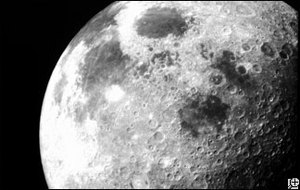
|
| ©Discovery News |
| Building Materials |
A NASA scientist has a practical idea for building a telescope on the moon. Rather than flying one there, use the lunar soil to make one on site.
We believe we have found a way to turn moon dust into a telescope," said Peter Chen, with NASA's Goddard Space Flight Center in Greenbelt, Md., and the Catholic University of America in Washington, D.C.
Chen, an inventor who has been working with carbon-fiber materials to produce high-quality telescope mirrors, began experimenting with tiny tubes of carbon, called nanotubes, glue-like epoxies and crushed rock that resembles lunar dust.
"First we had something very gooey and smelly," Chen told reporters at the American Astronomical Society meeting in St. Louis, Mo., last week. "Then we had this very hard, very stable material like concrete."
The substance could be used to make not only a telescope's support structure, but its light-collecting mirror as well. A small amount of aluminum coating would provide reflectivity.
Chen and colleagues already have built a model telescope using the simulated lunar dust and believe the technique could be scaled up to manufacture a 50-meter observatory. The world's largest telescope is currently the 10.4-meter Gran Telescopio Canarias on La Palma, Canary Islands.
A larger surface to collect light gives astronomers an opportunity to image more distant and fainter celestial targets. On Earth, the largest and most sophisticated optical telescopes use software to compensate for atmospheric distortions, which would not be an issue on the air-less moon.
Getting to the moon is another matter. The United States, in partnership with other countries, plans to redirect human space exploration from low-Earth orbit to the moon and eventually other destinations in the solar system. Astronomical observatories are among the most popular lunar science program proposals, though the high cost of transportation to the moon is a problem.
Chen believes building in situ is the answer.
"We could make huge telescopes on the moon relatively easily, and avoid the large expense of transporting a large mirror from Earth," he said. "Constructing giant telescopes provides a strong rationale for doing astronomy from the moon."
The same technique could be used to build habitats for astronauts and mirrors to collect sunlight for solar energy, Chen added.
"Since most of the materials are already there in the form of dust, you don't have to bring very much stuff with you and that saves a ton of money," he said.



Reader Comments
to our Newsletter